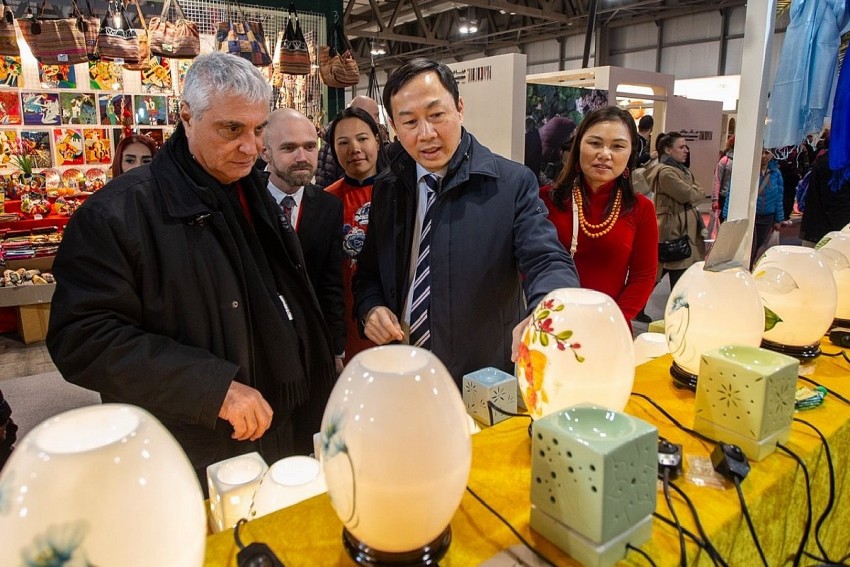Many solutions needed for sustainable handicraft exports
- 14
- Brand
- 10:32 10/10/2024
DNHN - To achieve sustainable handicraft exports, a long-term strategy is required, ranging from improving production capacity and enhancing brand value to leveraging e-commerce.
Promising numbers
Vietnam's handicraft industry has been affirming its position in the international market; however, to boost exports and fully exploit the potential of the industry, more practical solutions are needed in the near future. At the seminar "Consulting on enhancing marketing capacity for handicraft village export products" on October 9, 2024, Mr. Tôn Gia Hóa, Vice Chairman of the Vietnam Handicraft Village Association, highlighted the opportunities and challenges the industry is facing.
According to the latest figures, the global handicraft market was valued at USD 1.007 trillion in 2023 and is forecast to reach USD 1.107 trillion in 2024. By 2032, the industry's value could rise to USD 2.394 trillion. Vietnam, with more than 5,400 craft villages and traditional villages, possesses a valuable resource stemming from its cultural diversity and long-standing craftsmanship. The total revenue from these craft villages has reached around VND 75 trillion, with export turnover increasing from USD 1.62 billion in 2015 to about USD 3.5 billion in 2023.

Vietnamese handicraft products have reached 163 countries and territories, with key markets including the U.S., Japan, the European Union, and Middle Eastern countries. Particularly, the goal of achieving USD 4 billion in exports by 2025 is the industry's main ambition. However, compared to the scale of the global market and competitors like China and India, this remains a relatively modest figure.
Despite many achievements, Vietnam's handicraft industry still faces numerous challenges in exporting. Most handicraft production facilities still operate under family or village models, lacking professionalism and systematic production processes. This has led to products often being exported as outsourced goods or under orders from major international retailers, reducing the ability to build and develop the Vietnamese brand globally.
Highlighted handicraft products like Bát Tràng ceramics, Phú Vinh bamboo and rattan, Vạn Phúc silk, and Quất Động embroidery, while maintaining certain positions, have yet to make significant breakthroughs in branding. The competitiveness of Vietnamese handicraft products remains limited, especially when compared to international competitors who possess strong industrial foundations and more effective global market strategies.
A new direction for sustainable production
One of the positive signals for Vietnam's handicraft industry is the robust development of e-commerce. With Vietnam's e-commerce market ranking in the top 3 in Southeast Asia, this is seen as a significant opportunity for handicraft businesses to access international markets. Utilizing digital platforms not only helps expand export scales but also reduces reliance on traditional outsourcing orders.
Notably, sustainable production factors are increasingly valued in Vietnam's handicraft value chain. This not only meets the growing demand for environmentally friendly products from international consumers but also helps enhance the value of the Vietnamese brand in the global market.

According to Mr. Tôn Gia Hóa, to truly achieve sustainable development, Vietnam's handicraft industry needs comprehensive solutions in economic-social, environmental, and institutional areas. Particularly, a complete development master plan for the industry needs to be established, and science and technology should be promoted in product design and production processes.
Additionally, building a distribution and export network, as well as enhancing the role and efficiency of industry associations, are important factors. In the future, establishing a dedicated law for craft villages will be a breakthrough step, creating favorable conditions for preserving and sustainably developing handicraft production facilities.
The industry needs to focus on improving the competitiveness of core product groups, increasing product value, and diversifying designs to meet various market segments. At the same time, international standards compliance is also an indispensable factor for Vietnamese handicraft products to go further on the international stage.
Linh Anh
Related news
#Vietnamese businesses

Billionaire Trần Bá Dương’s Thaco raised 1.3 trillion VND in bonds
Thaco has successfully issued a 1.3 trillion VND real estate-backed bond, continuing its strategy of raising large amounts of capital, bringing its total bond liabilities to 13.68 trillion VND.

Economic expert Võ Trí Thành assessed: President Donald Trump’s new trade policy will impact Vietnam
According to Dr. Võ Trí Thành, Director of the Institute for Brand and Competitive Strategy Research, Donald Trump’s new trade policy will have significant effects on Vietnam’s economy. He also provides strategic recommendations for businesses.

Honoring the spirit of the business community and entrepreneurs
October 13 is not only an occasion to honor the achievements of the business community but also to recognize the relentless efforts of Vietnamese entrepreneurs in nation-building.

Chairman of VINASME: Vĩnh Phúc businesses confidently aim for sustainable development
The Chairman of the Vietnam Association of Small and Medium Enterprises (VINASME) emphasized that businesses in Vĩnh Phúc province are solidifying their position for sustainable development.

Two Vietnamese developers featured in Apple's latest honors project
The app named DreameChaser by two Vietnamese developers is among the few listed in the "Dare to Dream" category on the App Store.

The data center market in Vietnam: High demand, great potential
According to Minister of Information and Communications Nguyễn Mạnh Hùng, investing in data centers is a new type of investment for telecom operators.
Đọc thêm Brand
Hoàng Hải Anh and his young peers launch MR. Burgers – a Halal dining destination in Hanoi
At the age of 18, Hoàng Hải Anh (Haris) and his friends have introduced MR. Burgers, bringing the clean Halal food experience to visitors in Hanoi.
SK Innovation and HD Hyundai (South Korea) step up cooperation with Khánh Hòa Province (Vietnam)
The new cooperation and investment expansion plans of South Korea’s leading conglomerates reaffirm Khánh Hòa’s growing appeal in the eyes of international investors.
A trade fair organizer surprises by joining the ranks of top-earning listed companies
Financial results for Q2 and the first half of 2025 have been announced by numerous companies listed on the Vietnamese stock market.
HDBank secures USD 215 million syndicated loan from JICA, SMBC, and FinDev Canada
HDBank has signed a syndicated loan agreement worth USD 215 million with three international financial institutions: Sumitomo Mitsui Banking Corporation (SMBC), FinDev Canada, and the Japan International Cooperation Agency (JICA).
Sao Mai Group’s pangasius export segment embraces new opportunities
IDI – a member of Sao Mai Group – is building its third factory, aiming to significantly enhance export capacity to capitalize on new opportunities in the U.S. market.
The foundational mark of pioneers in renewable energy amidst an evolving legal framework
Vietnam’s renewable energy journey was marked by bold early investment at a time when the legal framework was still taking shape.
LAMORI – The Spirit of Lam Kinh in Every Breath
LAMORI is more than a luxury retreat—it is a harmonious convergence of boundless nature and sacred historical roots.
The Đại Dũng Group: A 30-Year journey of developing a sustainable value chain
In the context of globalization and sustainable development trends, Đại Dũng Group stands out with its 30-year journey in the fields of mechanical manufacturing, construction, and steel structure.
Rediscovering connection – a journey of discovery at LAMORI
LAMORI Resort & Spa is more than just a retreat; it is a destination for souls seeking reconnection, where every moment brings a meaningful experience.
Southern Vietnamese woman takes Ngoc Linh netted rice paper to all corners of the world
The Cai Be craft village has long been famous for many specialties of the Southern region of Vietnam. However, if it weren't for an unexpected event over 20 years ago, people would not know how Ngoc Linh netted rice paper has spread globally.











